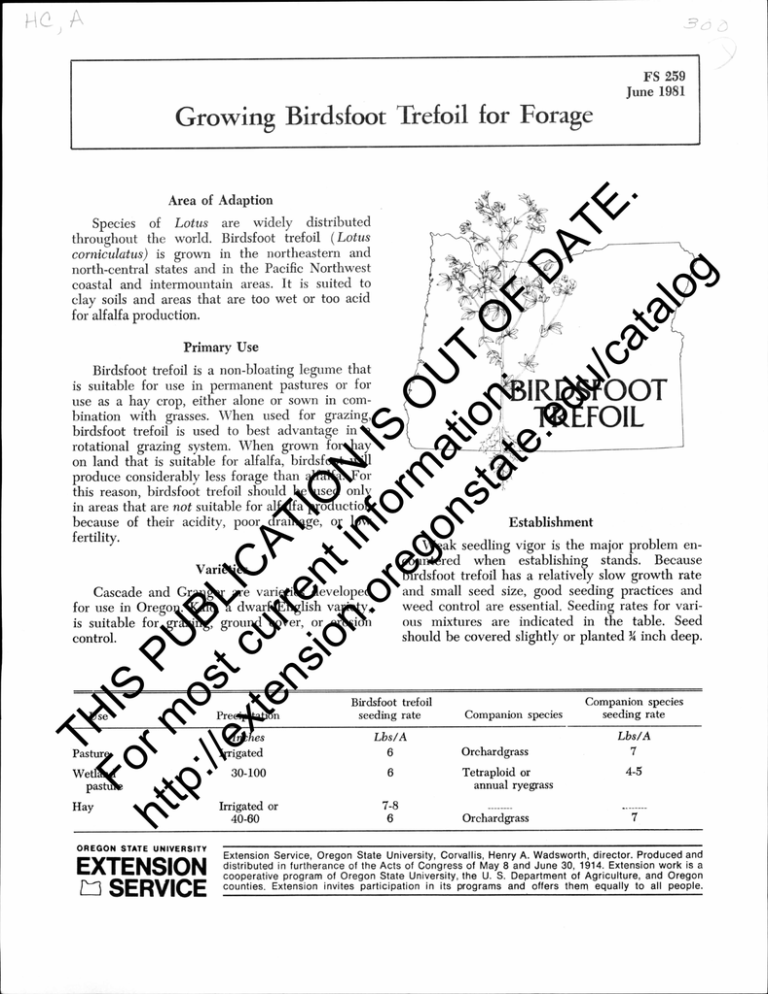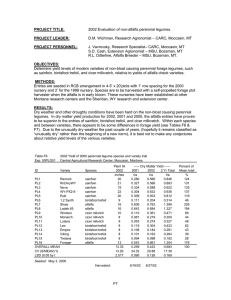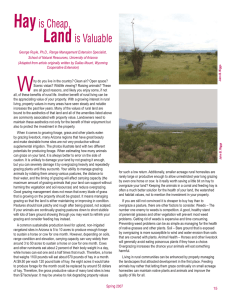DATE. Growing Birdsfoot Trefoil for Forage
advertisement

Ha, A E.1 FS 259 June 1981 Fo IS ht r m P U tp o :// s BL ex t c IC te ur A ns re TI io nt ON n. in or fo IS eg rm O on at U st ion T O at : F e. D ed A u/ TE ca . ta lo g Growing Birdsfoot Trefoil for Forage Area of Adaption Species of Lotus are widely distributed throughout the world. Birdsfoot trefoil (Lotus corniculatus) is grown in the northeastern and north-central states and in the Pacific Northwest coastal and intermountain areas. It is suited to clay soils and areas that are too wet or too acid for alfalfa production. Primary Use Birdsfoot trefoil is a non-bloating legume that is suitable for use in permanent pastures or for use as a hay crop, either alone or sown in combination with grasses. When used for grazing, birdsfoot trefoil is used to best advantage in a rotational grazing system. When grown for hay on land that is suitable for alfalfa, birdsfoot will IRDSFOOT TREFOIL produce considerably less forage than alfalfa. For this reason, birdsfoot trefoil should be used only in areas that are not suitable for alfalfa production because of their acidity, poor drainage, or low Establishment fertility. Weak seedling vigor is the major problem en- countered when establishing stands. Because Varieties birdsfoot trefoil has a relatively slow growth rate and small seed size, good seeding practices and weed control are essential. Seeding rates for vari- Cascade and Granger are varieties developed for use in Oregon. Kalo, a dwarf English variety, is suitable for grazing, ground cover, or erosion ous mixtures are indicated in the table. Seed should be covered slightly or planted 34 inch deep. TH control. Use Pasture Wetland pasture Hay Precipitation Inches Irrigated EXTENSION SERVICE n Lbs/ A 6 30-100 6 Irrigated or 7-8 6 40-60 OREGON STATE UNIVERSITY Birdsfoot trefoil seeding rate Companion species Companion species seeding rate Lbs/ A Orchardgrass Tetraploid or annual ryegrass Orchardgrass 7 4-5 7 Extension Service, Oregon State University, Corvallis, Henry A. Wadsworth, director. Produced and distributed in furtherance of the Acts of Congress of May 8 and June 30, 1914. Extension work is a cooperative program of Oregon State University, the U. S. Department of Agriculture, and Oregon counties. Extension invites participation in its programs and offers them equally to all people. Planting seed above a band of fertilizer ( band seeding) but not in contact with the fertilizer to graze when the first flowers appear. For use as pasture, this will allow two grazing periods on dry- will enhance seedling vigor. Birdsfoot trefoil, like land pastures west of the Cascade Mountains or three grazing periods on irrigated land. If used as a combination of hay and pasture, a hay crop can be taken at early bloom ( June) and the regrowth grazed at first flower. On irrigated areas, two regrowths can be expected and can be all legumes, should be treated before planting used as hay or pasture. The third hay crop, or grazing period, can be expected in September. Regrowth can be grazed in October and No- Fo IS ht r m P U tp o :// s BL ex t c IC te ur A ns re TI io nt ON n. in or fo IS eg rm O on at U st ion T O at : F e. D ed A u/ TE ca . ta lo g with the proper strain of Rhizobium bacteria that will fix atmospheric nitrogen. This nitrogen eliminates the need for using fertilizer nitrogen. Be sure to use the correct inoculum for birdsfoot trefoil (Lotus corniculatus), as the bacteria used for alfalfa or other legumes are not effective in nodulating birdsfoot trefoil. Even inoculum for other trefoil species will not effectively nodulate birdsfoot trefoil. Planting can take place in the early spring or late summer. Early spring planting- is preferable because of ample soil moisture for germination and seedling development. Fertility and pH Requirements One of the major advantages of birdsfoot trefoil is its tolerance to low fertility and to low soil pH. However, maximum forage growth will occur on fertile soils with a pH of 6.0 to 6.2. A moderate application of phosphorus and sulfur at planting, based on soil test data, will provide for good growth. vember. Persistence Birdsfoot trefoil is persistent and has a long life when managed properly. It is relatively free of insect and disease damage, and is very winter hardy once established. The most likely causes of loss of stand are continuous, hard grazing; competition through shading from too much grass and weeds; and excessively poor drainage such as standing water. Allowing some seed production during lenient grazing in summer will thicken the stand as the shattered seeds germinate quickly with irrigation or rain. Management Early spring or continuous grazing of birdsfoot TH trefoil will weaken and eliminate a stand. Rotational grazing should be used, allowing animals By David B. Hannaway, Extension agronomist, and William S. McGuire, professor of agronomy, Oregon State University.





